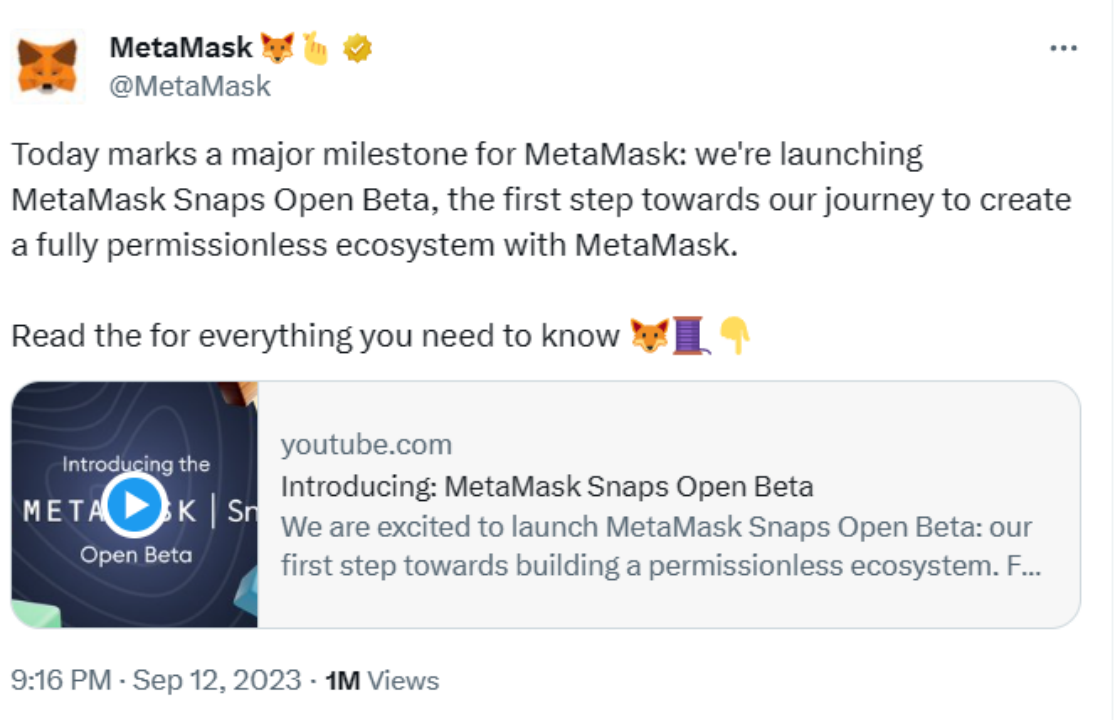veDAO Research Institute: EVM vs non-EVM, who is the future direction?
On September 12, the blockchain wallet MetaMask launched a beta feature called Snaps, which will allow third-party developers to customize wallet features and other mechanisms, which allows the MetaMask wallet to be seamlessly used for non-EVM (Non -EVM) Operation of assets on the blockchain. This version can be said to be another step towards MetaMask being completely unconditional and decentralized; another thing worth noting is that MetaMask is also beginning to be compatible with non-EVM. This article will analyze the difference between EVM and non-EVM to further understand the similarities and differences between these two blockchain virtual machines.

EVM and non-EVM
Ethereum Virtual Machine (EVM)
The Ethereum Virtual Machine (EVM) is the first virtual machine created for the blockchain industry. It is an abstraction layer between physical machines (nodes) and smart contract code. It allows programs running on it to be isolated from each other and from the main Ethereum chain. A simple understanding is that a chain built based on the Ethereum ecosystem can be rapidly developed and iterated. This reduces the development workload and avoids starting from scratch. Each Ethereum node runs an instance of the EVM, and they work together to form a kind of network or global decentralized computer. As Vitalik Buterin said, Ethereum has even been called the world computer.
The EVM is the heart and soul of the Ethereum network, and it is the platform on which smart contracts are deployed and executed. The physical instantiation of the EVM cannot be described in the same way as a cloud or an ocean wave, but it does exist as an entity maintained by thousands of connected computers running Ethereum clients. The EVM is Turing complete, which means if there is a question it will find the answer. Users can create smart contracts using Ethereum’s programming language Solidity and send them to the EVM for interpretation and execution. Simply put, the benefit of EVM is that it is easier to achieve interoperability with the Ethereum ecosystem. Inheriting the existing dApps on the Ethereum chain; however, the disadvantage is also obvious, that is, it is constrained by the Ethereum roadmap, which may interfere with the project teams plan, and it must follow the rhythm of Ethereum.
Non-EVM virtual machine (Non-EVM)
Other blockchains have chosen a different path with EVM compatibility and are known as non-EVM blockchains. Non-EVM is understood as a blockchain virtual machine that is completely separated from the Ethereum ecosystem and rebuilt by developers and project parties. This means that non-EVM is independent of the Ethereum roadmap and therefore will have lower fees and faster speeds than Ethereum. However, it faces many obstacles. Developers and users have to re-enter a new ecosystem, and the entry cost is high. Nonetheless, it is clear that non-EVM chains have greater room for innovation and can be completely free from the constraints of Ethereum.
The difference between EVM and non-EVM
EVM chain share and market capitalization (data source: defillama)
EVM is compatible with Ethereum, but non-EVM is not compatible with Ethereum. For example, the two are two different smartphone systems. For example, the Android system in our mobile phone is EVM, and the Apple system is non-EVM. So as long as it is based on the Android system All developed applications can be used on Android phones, which we collectively call EVM. However, software developed based on Apple systems cannot be installed and used on Android systems, which we collectively call non-EVM.
The more well-known EVM chains include Ethereum, Bsc, Arbitrum, Polygon, Avalanche, etc., while non-EVM chains include Solana, Mixin, DefiChain, Osmosis, EOS, etc.
Non-EVM chain proportion and market capitalization (data source: defillama)
Currently, most of the top ten blockchains are compatible with EVM, and EVM remains the market leader among public chains. But emerging non-EVM blockchains are also growing rapidly.
EVM and non-EVM features
The function of EVMs and non-EVMs (hereinafter collectively referred to as blockchain virtual machines) is to determine and track the status of each network block. Although it sounds like a monitoring tool, it actually refers to state changes, which are signals or causes of action in various computer systems. For example, state changes occur when something is opened or closed, activated or deactivated, sent or received, or when a file or document is moved. These state changes will lead to modifications to the computing system data structure.
The blockchain virtual machine can review network and dApp status changes, allowing the public chain and the dApps on its chain to work in a decentralized manner while solving problems such as network saturation or operation priority. In this way, the blockchain virtual machine allows any developer to run code in an ecosystem that does not require third-party trust, and the results of the execution and interaction of the software are guaranteed and predictable.
The debate between EVM and non-EVM
There has long been a debate between EVM chains and non-EVM chains. While it seems like EVM virtual machines are the clear winners, non-EVM chains like Solana make this battle worth watching. EVM compatibility is the primary requirement for evaluating public chain platforms.
Taking advantage of Ethereum, EVM-compatible public chains can quickly acquire customers and grow early, benefiting in terms of developer friendliness, user experience, and ecosystem incentives, but they must be integrated with many other chains in the Ethereum ecosystem. compete. Non-EVM-compatible chains are more likely to develop in trending areas and niche markets where new ideas emerge. At the same time, various public chains can succeed in areas such as NFT, GameFi, and payments.
Overall, its hard to say which one is better, EVM chains or non-EVM chains. Attracting Ethereum traffic is the fastest way for new chains to grow, and EVM compatibility is the most convenient solution; non-EVM can choose the development direction according to needs and is not restricted by the main chain.
Let’s look at the pros and cons of each to understand what EVM and non-EVM actually look like.
Advantages and Disadvantages of EVM and Non-EVM
EVM
Advantages of EVM
As mentioned above when introducing EVM, since EVM enables anyone to develop decentralized applications, there are no security barriers or restrictions. The scalability of EVM and the relatively simple process of migrating from the Ethereum ecosystem make projects more accessible to users. Based on the convenience of EVM, NFT has become one of the popular contents in the crypto world.
Disadvantages of EVM
Although decentralized, the EVM network is not completely decentralized. The vast majority of Ethereum nodes are hosted on Amazon Web Services’ centralized cloud servers. If the operators of these services decide they don’t like Ethereum for any reason, nodes may be rejected, harming the network.
When the network is congested, gas charges will be high. This could cause significant inconvenience to Ethereum users, and while those sending large transactions may not be affected, those sending smaller transactions may experience network access issues for a period of time. When many users interact with DApp smart contracts and perform a large number of transactions, if the gas fee is too high, it will have a lot of negative impacts on the project.
Due to its rigid bytecode language and native functionality, EVM is too complex and does not have enough virtual machine capabilities to implement a secure design. Additionally, due to the rules of Ethereum and the EVM, designers need to implement many of the EVMs features and key parts of the execution model themselves.
Non-EVM
Advantages of non-EVM blockchains
Non-EVM enables programmers to expand their user base and application scope. For example, the projects on the Solana chain, Raydium and Serum, are exclusive to Solana. Once upon a time, Terra was a unique public chain designed to connect on-chain and off-chain payments. Additionally, EVM-incompatible platforms can provide end users with fast transaction times and cheap transactions.
These advantages make non-EVM blockchains an emerging choice in specific use cases and markets, providing developers and users with more choice and flexibility.
Disadvantages of non-EVM blockchains
High development costs: Chains that are not EVM compatible may require additional development work to adapt to their unique ecosystems and rules, which may result in higher development costs.
High barrier to entry: Non-EVM compliant chains may have a high barrier to entry for developers and users as they need to adapt to new tools, technologies, and ecosystems.
Difficulties in project migration: Migrating a project from an EVM-compatible chain to a non-EVM chain may face some challenges, including the need to rewrite smart contracts and adapt to the new ecosystem.
Since non-EVM compatible chains have obvious disadvantages in the number of projects, developers are more inclined to choose EVM compatible chains.
Because they can be quickly copied and deployed to new chains, this can help save time and costs.
Conclusion
So, in the competition between EVM and non-EVM chains, who wins? There is no clear winner between the two, as each situation is unique and developers must choose the public chain that corresponds to the development path of their project. Different projects and use cases may be better suited to different chains, so no one chain can be absolutely chosen over another; decisions should be made based on specific needs and project goals. EVM compatibility can help developers attract traffic and expand the ecosystem as Ethereum users can quickly migrate to new chains. At the same time, non-EVM compatibility will undoubtedly allow developers to experiment and innovate.
In the blockchain world, no one chain fits all needs, so developers and project teams must make choices based on their unique goals and use cases in order to achieve the best results. Therefore, in the long run, EVM will not be the only one in the future. The coexistence of multiple chains is the direction of the blockchain. After all, the diversity and constant evolution of the blockchain ecosystem is its essence.
Reference documentation:https://ethereum.org/en/developers/docs/evm/
About veDAO
veDAO is a Web3 investment decision-making platform driven by AI technology. It conducts big data analysis through sentiment indicators and on-chain and off-chain indicators to discover trends and accurately capture Alpha. By building AI advisors, we help users invest efficiently and profit.
Website:https://app.vedao.com/



